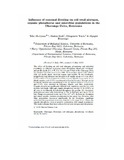Influence of seasonal flooding on soil total nitrogen, organic phosphorus and microbial populations in the Okavango Delta, Botswana
Date
2003Author
Mubyana, T.
Krah, M.
Totolo, O.
Bonyongo, M.
Publisher
Journal of Arid Environments. http://www.elsevier.com/wps/find/journaldescription.cws_home/622855/description#descriptionType
Published ArticleMetadata
Show full item recordAbstract
The effect of flooding on soil total nitrogen, phosphorus and microbial
population in different vegetation zones (floodplain, island and woodland)
and profile depth (0?1, 0?5, 2?0, 3?0, 4?0 and 5?0m) of the Okavango Delta
was studied from February to July 1999. Total nitrogen significantly differed
with soil profile depth, moisture regime and months. In the woodlands,
insignificant total nitrogen was detected at all depths except at 0?1m, where
0?03% and 1?17% were detected in February and March, respectively. In the
island samples, only 0?05% was detected at 4m in February. Nitrogen in the
floodplain samples was concentrated in the A1 horizon where 0?12%, 0?61%
and 0?03% were detected in February, March, and May, respectively.
Organic phosphorus significantly differed with vegetation zone but not with
months and depth. Although organic phosphorus was low (0?02–0?52%) at
all sites, it was liberally distributed throughout the profiles. On the island,
actinomycetes were only detected up to 2m in February and up to 3m in
July. Fungi concentrated in the top 0?5m (103–105). In both the floodplain
and island samples, bacteria concentrated in the upper 3m. However, after
May, populations decreased significantly. In the floodplain, significant
actinomycetes populations were only detected in the upper 0?5m. Generally,
organic phosphorus showed positive correlations with fungal populations.
This study indicates that these soils are low in total nitrogen and phosphorus.

